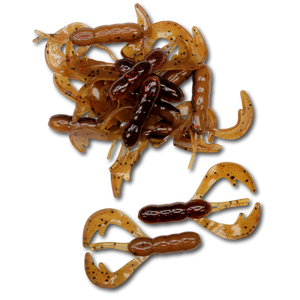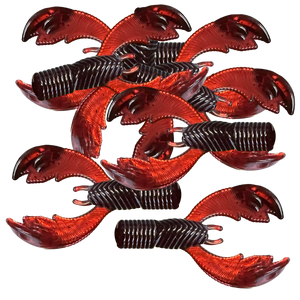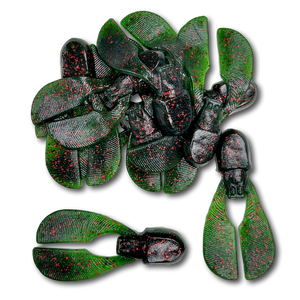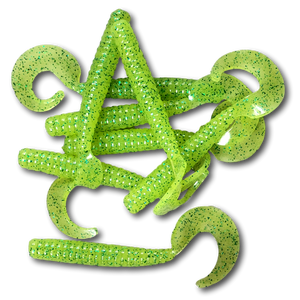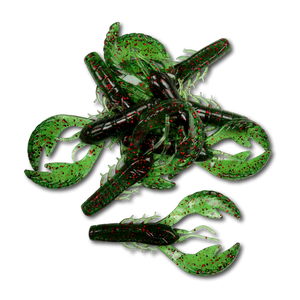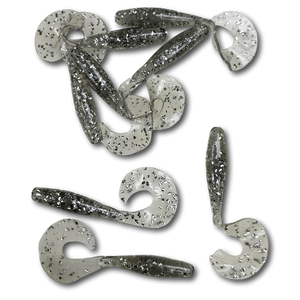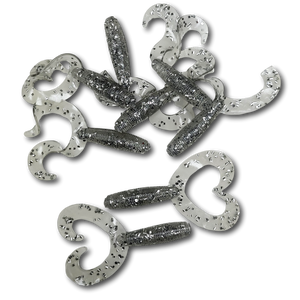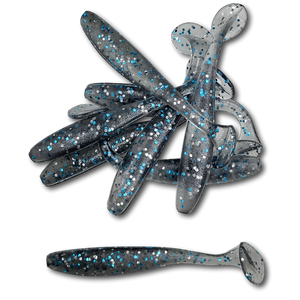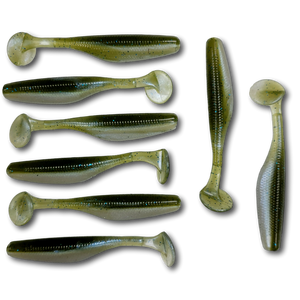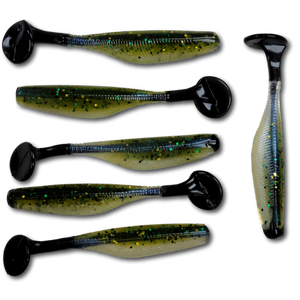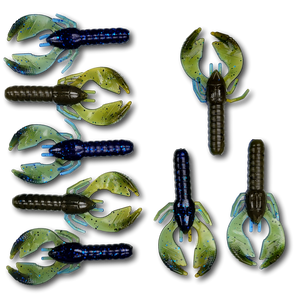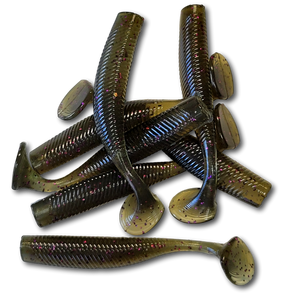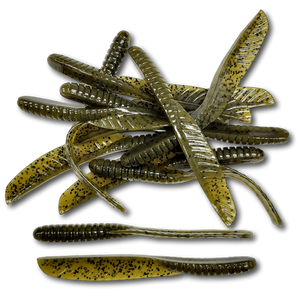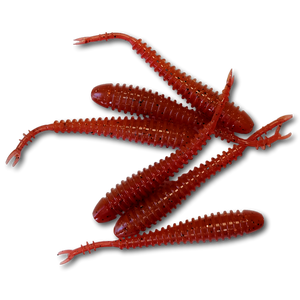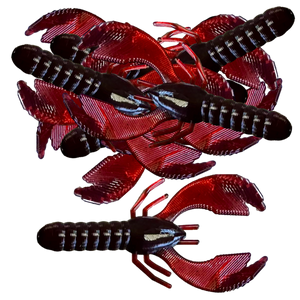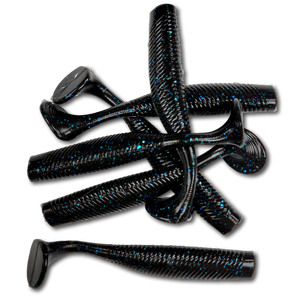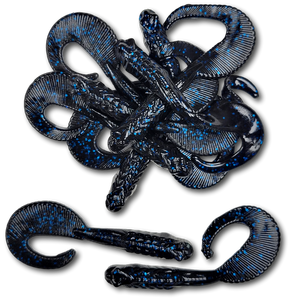Trailers
Jig Trailers: Complete Selection, Rigging & Color Guide
Match trailers to swim, football, bladed & finesse jigs—with seasonal picks, retrieves, and quick fixes.
What is a Jig Trailer?
A jig trailer is a soft plastic that threads onto a jig hook shank to amplify profile, hydrodynamic action, and sometimes scent dispersion. It turns a bare jig into a defined forage signal—craw on bottom, baitfish in the column, bluegill over grass—so fish can identify and commit.
- Why it works: bulk increases displacement; appendages or tails add vibration; colors/translucency match local forage; salt/scent extends hold time.
- Trailer length: as a baseline, the tail should extend 1 to 2 inches past the skirt, but this depends greatly on the profile and the size of the trailer. Experiment to get the action you are looking for. Longer = more thump/drag, shorter = tighter action and better skipping.
- Buoyancy: floating plastics keep claws up at rest (craw posture). Denser, salted plastics sink faster and pulse on the fall.
How Trailers Pair with Jig Types
- Swim jigs: 3–4” paddle-tail swimbaits, pintail shad, leech profiles, or twin-tail grubs. Retrieve speeds: slow roll in cold/clear; medium burn in stain; brief rod pops to flare skirt.
- Flipping / pitching: creature baits & craws with kicking appendages. Choose stronger claws in stain/current; slimmer in cold fronts.
- Football jigs: wider-body craws or beaver-style trailers that glide and hold horizontal when dragged across rock.
- Bladed (chatter) jigs: streamlined swimmers that don’t block the blade. Overly flappy claws can cancel vibration—if the thump dies, the trailer is the first suspect.
- Finesse jigs: compact chunks/craws/grubs. Think tight action, small profile for pressured fish and bluebird days.
Tackle synergy: medium-heavy rods for flipping/football; moderate-fast for swim/bladed; line 12–20 lb fluoro (or braid to leader in grass).
Forage & Materials
- Craw trailers: best anywhere crayfish live—rock, wood, transitions. Red/orange in pre-spawn; green pumpkin/black blue year-round.
- Swimbait / minnow: shad/bluegill imitators for open water, grass edges, and shad pushes in fall.
- Creature / hybrid: off-beat appendages to show pressured fish something different; great behind flipping and casting jigs.
- Pork-style soft plastic imitations: mimic old-school pork’s texture and buoyancy with easier handling and more color control.
Material notes: avoid mixing incompatible plastics in the same box (certain TPE elastomers can melt standard PVC baits). Store by material and color family.
Swim Jig Trailers – Speed & Flash
Paddle-tail swimbaits create consistent thump and body roll; split-tails shine in clear/cold water with subtle flash. Rig perfectly straight—any kink causes roll and kills confidence.
- Cadence: low-gear slow-roll (40–50 IPT) in 48–55°F; medium in 56–68°F; burn or yo-yo when bait is fleeing.
- Angles: bring across the face of grass, down the contour, or quartering wind-driven banks. A 12–20° rod angle keeps the bait in the lane.
- Colors: shad/white/smoke in baitfish lakes; green pumpkin/bluegill over flats and edges; add pearl belly for stain.
Jig Trailers for Bass (LM/SM/Spots)
- Largemouth: high-action creatures or craws in stain/vegetation; compact craws in clear. Pitch to shade lines, laydowns, and isolated clumps.
- Smallmouth: compact craws and minnow shapes around rock, current, and points. Drag/pendulum the bait; let the claws “hover” on pauses.
- Spotted bass: slimmer swimmers and straight tails on bladed jigs or finesse heads around brush piles and timber edges.
If you’re missing short strikes, downsize the trailer ½″ and/or lighten the jig by one step to keep it higher in the column.
Best by Conditions (Finesse • Football • Bladed • Small Profiles)
- Finesse: 2–3″ chunks/craws/grubs with tight action for post-frontal bluebird days and community holes. Neutral, translucent colors excel.
- Football: wider craws that glide and hold posture when dragged. Pause at the top of rocks; many bites come on the settle.
- Bladed: streamlined swimmers or straight tails. If the blade feels muted, shorten the trailer or pick a slimmer body.
- Small profiles: ultra-clear water or small prey windows (young-of-year). Tie on 8–12 lb fluoro and keep movements minimal.
Water clarity rule: Clear = natural/translucent; Stain = contrast (black/blue, junebug); Muddy = silhouette and displacement.
How to Rig a Jig Trailer (Step-by-step)
- Align: hold the trailer beside the hook to mark the exit point; note where the head meets the skirt collar.
- Thread: enter dead-center and follow the bait’s spine. A 2–3 mm miss causes roll at speed.
- Seat: snug the nose to the skirt collar; if it bunches, trim 1–2 ribs off the head section.
- Orient: craws/chunks should rest claws up on bottom; swimmers should be perfectly straight for even tail kick.
- Tune: trim skirt to hook bend so the trailer breathes. Add scent if fish are nipping (longer hold time).
Failure modes: crooked threading (roll), over-long trailer (mushy feel), skirt masking (no action), too-stiff tail in cold water.
Seasonal & Weather-Based Selection
- Spring (pre-spawn 48–58°F): red/orange craws on rock/wood. Swim jigs slow-rolled around emerging grass.
- Spawn/guarding: compact craws/creatures teased in the nest periphery; short hops, long pauses.
- Summer: swimmers for covering water; creatures for punching mats/isolated clumps; darker tones in stain.
- Fall: shad migrations → white/pearl/smoke swimmers; speed up and follow wind lanes.
- Winter: downsize, subtle action, long pauses. Football + buoyant craws that hover on the spot.
Wind adds life; sun angle positions fish on shade edges. Adjust trailer action first, then color, then weight.
Common Mistakes & Quick Fixes
- Trailer too long: fish short-strike or miss – trim ½–1 rib.
- Muted chatter vibration: swap to a slimmer swimmer; shorten by ¼–½”.
- Roll on the retrieve: re-thread straight; check for bent keeper or asymmetrical tail.
- Skirt choke: skirt past hook bend masks action—trim shorter.
Maintenance & Storage
- Sun/heat: store out of direct light; soft plastics can warp or bleed dye.
- Separation: scented vs. unscented; salt-heavy baits can leach; keep by color family.
- Material compatibility: don’t mix TPE elastomers with PVC baits in the same slot—melting risk.
- On-water rotation: retire torn heads; keep trimmed pieces as emergency chunks.
FAQs
What’s the best trailer for a swim jig? 3–4″ paddle-tail for thump; split-tail for subtle flash in clear/cold water.
What pairs best with a football jig? Wider-body craws that glide and hold posture when dragged across rock.
What trailer for a bladed jig? Streamlined swimmers; if the blade feels muted, shorten the trailer or pick a slimmer body.
How far should the trailer extend? About ¼–½″ beyond the skirt; longer for displacement, shorter for precision.
Color rules of thumb? Clear = natural/translucent; Stain = contrast (black/blue, junebug); Pre-spawn = red/orange craws.
Do scents matter? They increase hold time and confidence—especially in cold fronts or heavy pressure.




